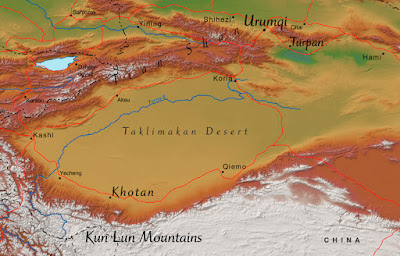China | Xinjiang | Khotan | Silk Factory
Wandered by Khotan on the southern edge of the Taklimakan Desert in western China. I was following the footsteps of Chinese Buddhist pilgrim and inveterate gadabout Xuanzang who visited Khotan circa 644 A.D. during his 17-or-so-year sojourn from China to India and back. He left the following account of what was then the kingdom of Khotan:
This country is about 4000 li in circuit; the greater part is nothing but sand and gravel; the arable portion is very contracted. What land there is, is suitable for regular cultivation, and produces an abundance of fruits. The manufactures are carpets, haircloth of the highest quality, and fine-woven silken fabrics. Moreover, it produces white and green jade. The climate is soft and agreeable, but there are tornadoes which bring with them clouds of flying gravel. They [the residents of the country] have a knowledge of politeness and justice. The men are naturally quiet and respectful. They love to study literature and the arts, in which they make considerable advance. The people live in easy circumstances, and are contented with their lot.
Location of Khotan (click on photos for enlargements)
To this day the products of Khotan have not changed much. Silk, carpets, and jade remain the city’s chief attractions. First I checked out the Silk Factory.
Graybeard at his loom in the silk factory
Silk worm cocoons
Closer view of the silk cocoons. Now about 40% of the raw silk cocoons are imported from Pakistan. Each cocoon, when unwound, contains about a one-kilometer-long length of silk filament.
The cocoons are heated over fires to kill the worm within, and then boiled to loosen the filaments. Then a mass of filaments are gathered together and twisted into one silk thread.
The silk thread runs from through the gadget in the middle to the foot-trundle powered spindle run by the woman on the left.
Spindle of pure silk thread
Skeins of pure silk thread
The main product of this factory is so-called atlas silk. The silk is tie-dyed using either chemical dyes or natural dyes made from local plants and minerals and then woven into four-meter-long lengths which can be used to make dresses, etc. The loom above is using chemically dyed thread.

Chemically dyed atlas silk
Naturally dyed atlas silk
Naturally dyed atlas silk
Huge skeins of dyed silk in the factory showroom. The naturally dyed silk is much more expensive than the chemically dyed version. One four-meter-length of chemically dyed atlas silk costs about $30, while the naturally dyed version cost about $72.
These are the prices at the factory. Even the stores in Khotan, like this one, itself charge much more, and in Urumqi the price is typically doubled, although of course hard bargaining can knock the price down considerably.
It might be added that Khotan, and the Taklimakan Desert in general, has been posited as One Of The Physical Locations of the legendary kingdom of Shambhala. However, Lamas in Mongolia staunchly maintain that Shambhala can be found only in the Seventh Dimension, and not in the mundane three-dimensional world that most—but not all!—of us know and love.
Superimposed here on the Taklimakan Desert is Kalapa, the capital of Shambhala. G. Nyam-Ochir, currently one of Mongolia’s leading Shambhalists

















